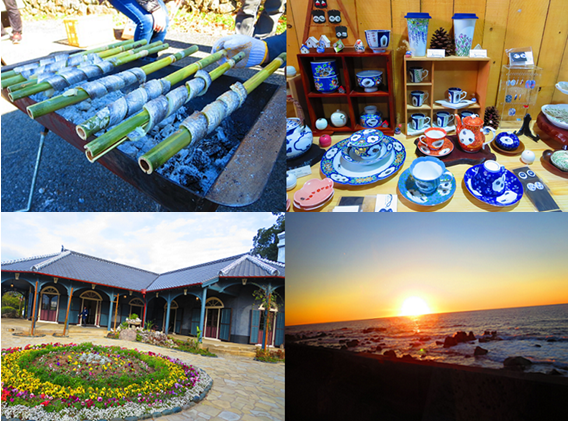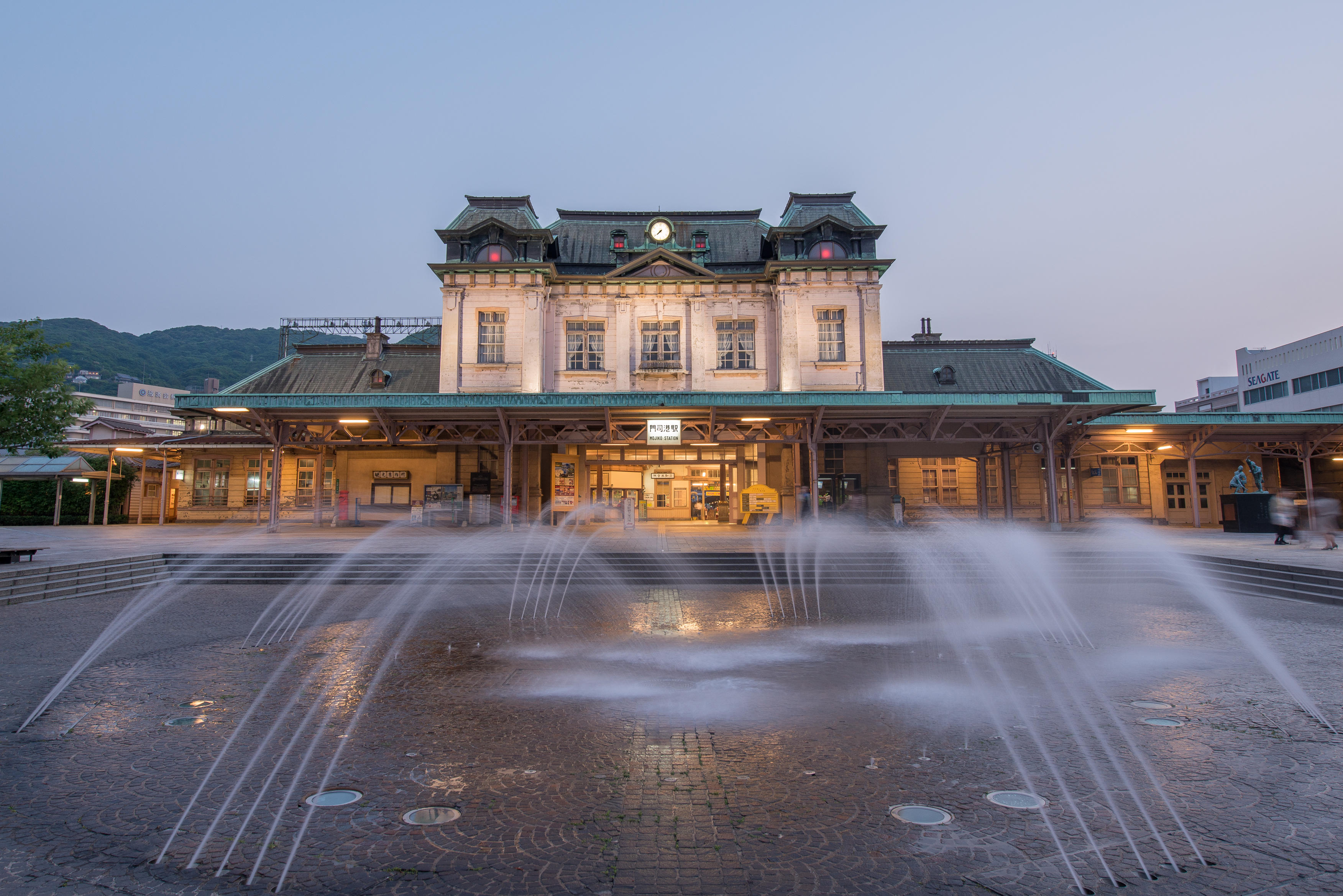
Located near China and Korea, Kyushu has long been a gateway to foreign trade and cultural exchange. During the Age of Discovery in the mid-16th century, Portuguese and Spaniards arrived in Kyushu, trade with Japan began, and Christian missionary work was actively carried out. Even today, hundreds of years later, you can still see a lot of the footprints in numerous places.
Through the trip to the northern and western parts of Kyushu, experience the fascinating culture and history in places closely related to foreign countries. The delicious foods unique to this area and shopping of delicate Arita ware are also the great attractions of this tour. At the end of your trip, walk along the beautiful coastline to enjoy nature and refresh your mind and body.
Sample Itinerary Overview
This itinerary assumes starting Day 1 in Kita Kyushu (Northern Kyushu) area, but it is customizable depending on where you stay.
Day 1 Arrive in Fukuoka or Kita Kyushu Airport / Sightseeing in Kita Kyushu City
Fly to Fukuoka Airport or Kita Kyushu Airport in Fukuoka prefecture. An English-speaking guide will meet you at the arrival lobby. First, move to Moji Port. After Japan's feudal system collapsed in 1869, the Kita Kyushu region played an important role in supporting the modernization of Japan in three areas: shipping, coal, and steelmaking. One of the ports that flourished as an international trading port was Moji Port. Today, this area transformed to Mojiko Retro, a nostalgia-like tourist attraction along with several preserved historical buildings. Observation deck on top floor of high-rise building offers a panoramic view of Moji Port, Kanmon Strait and Sea of Japan.

Below the strait is the Kanmon Tunnel, which connects Kyushu and Honshu (mainland Japan). It is the only undersea tunnel in the world that can be crossed on foot. Rent a bicycle and take a short round trip to Shimonoseki City, Yamaguchi Prefecture from Moji Port through this tunnel. There is a Karato Market famous for fresh seafood, especially blowfish. You should be able to feel the closeness of the distance between Kyushu and Honshu.
After that, move to Kokura, the center of Kita Kyushu City, and visit an impressive landmark, Kokura Castle. It was built in 1602 by Hosokawa Tadaoki, a warlord of the Warring States period. Inside the castle is the display of history that includes his wife, Hosokawa Gracia, who was baptized by Christian beliefs during the forbidden times.
At night, stay at Rihga Ryal Hotel Kokura, or a hotel in Kokura.
Day 2 Transfer to Arita and Enjoy Sightseeing
Transfer to Arita, Saga prefecture, by train. Arita is the birthplace of Japanese porcelain based on the Korean techniques. Since then, Arita ware has been handed down as traditional Japanese craft for 400 years. As a start, your guide will take you to Kyushu Ceramic Museum where you can learn the history of ceramics and see a variety of examples of old and contemporary works.
For lunch, enjoy meals served in a beautiful Arita ware box.
Then, you will visit Izumiyama Quarry designated as a national historic site. In 1616, a Korean potter discovered high-quality porcelain stone in this place, which led to the production of porcelain in Arita. Also, Sueyama (Tozan) Shrine is worth a visit. Torii gates, guardian dogs, and lanterns are all made of ceramics created by the skill of Arita's master craftsman.
There are a lot of recommended kilns to explore in the area. It is fun to look around kilns that produce works in traditional, contemporary, and artistic styles and find your favorite items. Special arrangements such as private guidance from kiln staffs, ordering, and factory tours can be made upon your request.
The surrounding area is a production center for different style porcelains such as Imari ware, Hizen Yoshida ware, and Hasami ware that also have a long history. If you would like to spend more time in the area, we recommend the best spots for each.
Move to Ureshino Onsen and stay at Wataya Besso, or a ryokan in this area.
Day 3 Transfer to Nagasaki and Enjoy Sightseeing
Take a leisurely walk in Ureshino Onsen town in the morning. There are free public hot spring footbaths in this area, and one of them is "Siebold's footbath". Next to it is the public hot spring facility "Siebold no Yu," which features an orange pointed roof. Philipp Franz von Siebold was a German doctor. Arriving in Japan in the early 19th century, he was assigned to work for the Dutch Trade Mission on Dejima, Nagasaki. These facilities were named this way because his travel journal describes the quality of Ureshino Onsen. Walk around to see a local Hizen Yoshida ware shop, and take a break at a stylish cafe where you can enjoy Ureshino brand tea.
Then, transfer to Nagasaki by Shinkansen. "Nagasaki Saruku" means that "Strolling Nagasaki" in local dialect that suggests strolling is the best way to get to know Nagasaki. Enjoy private tour by trolly train which is quite useful to tour major tourist attractions. Trolly train is also a means of transportation closely related to the lives of people so that you can get a glimpse of local lifestyle.
Back in the mid-16th century, local lord of Nagasaki area issued the Portuguese a permit for Christian missions, and several years later, the first Christian feudal lord, Omura Sumitomo, opened Nagasaki Port. As a major base, Nagasaki traded with Portugal, the Netherlands, England, and China. About 40 years later, Tokugawa Shogunate banned Christianity for the fear of foreign conquest. In 1639, the seclusion of the country, which lasted more than 200 years, began. Then, only Nagasaki was allowed to trade between the Netherlands and China. Dejima is an artificial island established to separate the Portuguese from Japanese society to prevent Christian missions and later to closely monitor the trade of the Dutch. Visit the restored facility and learn about the history. Tojin Yashiki, the site of former Chinese quarter, was constructed to monitor Chinese trade. After most of them burned down, Shinchi Chinatown was newly formed and is now the oldest Chinatown in Japan.
Then, next visit is Oura Church which is registered as National Treasure and UNESCO World Heritage Cultural Site - Hidden Christian Sites in Nagasaki Region.
You will hear stories about the discovery of hidden Christians here.
Glover Garden consists of the residences of Scottish trader Thomas Glover and other European settlers who contributed to modernization of Japan after 1859, when the long seclusion period ended and three ports, Nagasaki, Yokohama, and Hakodate reopened. This garden is registered as part of UNESCO World Heritage, Sites of Japan's Meiji Industrial Revolution.
You will visit Kofukuji Temple, a Chinese style Buddhist temple established in 1620. Maso, the guardian deity of voyage and fishing, is enshrined to pray for the safety of Chinese merchant ships. In 1654, Ingen, a Chinese high priest and Buddhist Zen master, became the chief priest of this temple. He had a great influence on Japan in various fields, architecture, sculpture, cooking, etc. Enjoy conversation with the current priest while tasting a cup of powdered tea and sweet. You will notice that a mixture of different cultures created a unique culture in this city.
Lastly, take Nagasaki Slope Car to the observatory on top of Mt. Inasa and enjoy the night view of Nagasaki that has been certified as one of the three new night views of the world.
Stay at Hilton Hotel Nagasaki, or a hotel in Nagasaki.
Day 4 Enjoy morning tour to Ioujima island, Transfer to Unzen, and move on to Amakusa
Take a ferry from Nagasaki Port to a small island resort, Ioujima. You can enjoy cycling here regardless of the season. Ride along the coastline and head to Ioujima Lighthouse. Take a break at a trendy café near the lighthouse for beautiful scenery.
Transfer to Shimabara area. While driving toward Obama Onsen, you can enjoy a magnificent view of the mountains centered on Mt. Unzen in the western part of the Shimabara Peninsula. It is a region blessed with the beautiful coastline of Tachibana Bay and the Ariake Sea.
At Obama Onsen, there is a 105-meter (344-feet) hot spring foot bath, Hot Foot 105, right in front of the sea. You can steam eggs and sweet potatoes using the steam of the hot springs in the steaming pot "Jigokumushi." Enjoy a hot snack while soaking your feet in the hot springs.
Move to Kuchinotsu Port and take a ferry to Amakusa. Amakusa Shimoda Onsen boasts a spectacular view of the beautiful sunset over the East China Sea. Stay at Boyokaku in Amakusa Shimoda Onsen, or a ryokan in this area.
Day 5 Move to Matsushima Port, Transfer to Ashikita to enjoy nature walk
Depart from the ryokan and drive through scenic Amakusa Gokyo, five bridges with a total length of 12km (7.4 mile) that connect the mainland of Kyushu and the Amakusa Islands. This drive route is nicknamed "Amakusa Pearl Line" since Amakusa has one of the largest shallow pearl farms in Japan.
As an option in Amakusa, a dolphin watching cruise is also available. There are more than 200 bottlenose dolphins off the coast of Amakusa, and you can see a herd of wild dolphins all year round. For those who are interested, it is possible to create an itinerary that includes this program.
Move to Ashikita Town, Kumamoto Prefecture and participate in the "Ashikita Adventure Footpath." The birthplace of Footpath is England, and there are roads that ordinary pedestrians can pass through not only public roads but also private roads in forests, old towns, etc. Recently, even in Japan, attractive sidewalks that take advantage of the characteristics of each area have been developed. The 8 km (5 mile) course begins on a quiet and scenic coastline.
You can watch the one-car Hisatsu Orange train that runs near the beach, visit a small old shrine, and enjoy interacting with local farmers.
Enjoy a lunch box made with local ingredients and grilled hairtail with bamboo. You can also have some tea and dried fruits from this area.
The goal of the Footpath is the park at Cape Otachi facing the Shiranui Sea. From here, the view of the blue sea and the islands of Amakusa is spectacular. Refresh yourself at the hot spring facility or taste ice cream containing a small amount of Ashikita's salt.
Your guide will take you to Kumamoto Airport or JR Kumamoto Station at the end of tour.
As an option, you can also take a train from Kumamoto Station to continue traveling the western or southern part of Kyushu. In addition to the Kyushu Shinkansen, we recommend the unique limited express trains that run in Kyushu. We are pleased to arrange further guided tours upon request. If you want to move around freely for the rest, the JR Kyushu Railway Pass can be recommended.
JR KYUSHU RAIL PASS|JR KYUSHU RAILWAY COMPANY
The tour price will differ according to various factors such as the choices of accommodation (e.g. 5-star, 4-star), transportation (e.g. train, private car), number of days with a private guide, duration of your tour, or seasonality. Please contact us. One of our tour consultants will come up with an ideal plan and cost for you.
Contact Us
For more information, or to start customizing your own itinerary, please contact us.
Michi Travel Japan
Tel: +81-3-5213-5040
